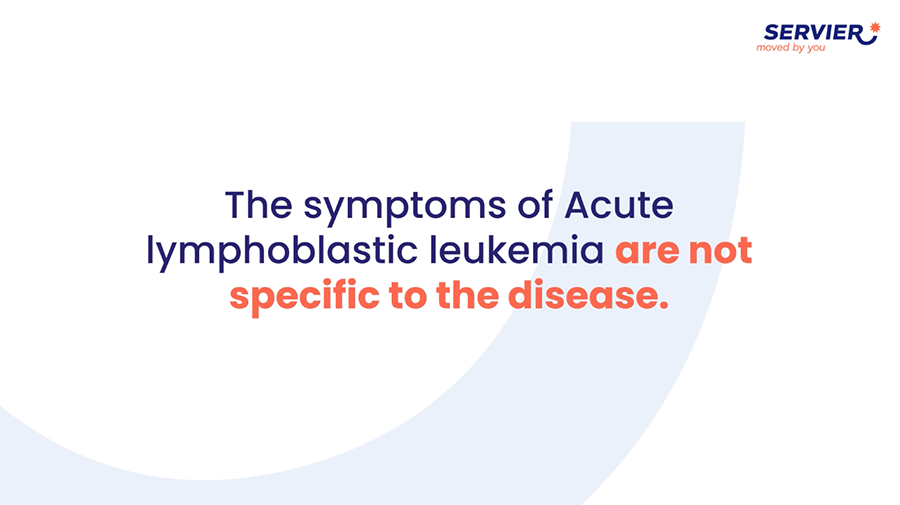Acute lymphoblastic leukemia is a bone marrow cancer that involves a specific type of white blood cells called lymphoblasts. This form of leukemia is a rare disease that affects children more frequently than adults, and more men than women1.
Acute lymphoblastic leukemia (ALL) is a type of cancer that affects bone marrow, the part of the body where the different types of blood cells are produced. These are erythrocytes, red blood cells responsible for carrying oxygen; leukocytes, white blood cells that help the body fight infection; and thrombocytes, or platelets that play a role in blood coagulation.
ALL affects the stem cells that give rise to lymphoblasts, which are white blood cells at an early stage of development. Instead of maturing and traveling towards the blood, these abnormal ‘blasts’ (cells that have not reached maturity) grow and divide uncontrollably. They invade bone marrow, interfering with normal blood cell production. Blasts may also reach other organs, such as lymph nodes, the liver and the spleen.
In children, the annual incidence (number of new cases during a given period in a given population) is 40 cases per million in European countries. This is essentially the same in all developed countries. Peak incidence occurs between 0 and 5 years of age2 in Europe and the United States.
90%
This is the cure rate in children in industrialized countries. 3
40 per 1,000,000 individuals
This is the annual incidence rate for ALL in Europe in children.2
80%
In Europe, 80% of all leukemias in children under the age of 154 are ALL.

What are the risk factors for ALL?
ALL, which is neither contagious nor hereditary, has no known cause or trigger factor. In the majority of cases, it occurs in subjects who were in good health before diagnosis. However, several risk factors have been identified:
What treatments are available for acute lymphoblastic leukemia?
Acute lymphoblastic leukemia is a disease whose symptoms may vary, depending on the patient. This is why treatments will also vary from patient to patient, according to how the disease manifests.
Induction chemotherapy

To begin treatment, the patient may undergo induction chemotherapy and be hospitalized for at least a month. This type of chemotherapy induces bone marrow aplasia, leading to a very substantial reduction in the number of blood cells. It aims to eliminate cancer cells, which will allow blood cells to regenerate normally.
Consolidation
In addition, consolidation is sometimes suggested. This involves a bone marrow transplant of hematopoietic stem cells. Donations can come from a compatible donor (family, donor registry), but can also be obtained from placental/umbilical cord blood (PCB), also called cord blood.
Maintenance
Cancer cells can infiltrate the meninges, membranes surrounding the brain and spinal cord. This neuro-meningeal involvement is a major cause of relapses in the first year of treatment. To prevent these, outpatient maintenance treatments such as cranial radiotherapy (PCR)and/or intrathecal (IT) chemotherapy may be administered for two years.
In the event of relapse, more chemotherapy is prescribed, starting with reinduction therapy, followed by additional maintenance and consolidation phases. A hematopoietic stem cell transplant may also be considered, originating from healthy donors (allograft).
New therapeutic approaches
While the response rates observed after standard treatments are generally high, some patients will experience drug resistance or relapse. Research has shown that cancer cells can develop mechanisms for escaping the patient’s immune system, which enables them to slip under the radar and not be recognized as dangerous. These cancer cells can then multiply unchecked in the patient’s body.
New therapeutic approaches to treat these patients are being studied. Today, they are at varying stages of development. Some may target the immune system in order to restore its ability to destroy cancer cells. These targeted therapies are based primarily on the use of specific antibodies for certain tumor cell markers, and immunotherapies.

About Servier?
Faced with the ever-increasing occurrence of cancer and the growing need for therapeutic solutions, Servier has made oncology one of its foremost priorities. We invest more than 70% of our R&D budget in the field.
Our ambition is to become a focused and innovative player in oncology, developing treatments for hard-to-treat cancers with needs that are for the most part still unmet.
This is why we are focusing on promising approaches such as immune-oncology, which aims to reactivate the immune system, and targeted therapies – specifically to fight resistance to apoptosis and cancer cell metabolism. To more appropriately address patient needs, we work with physicians and patients, and have developed a network of diverse partners.
Remember
[1] American Cancer Society -cancer.org | 1.800.227.2345 – October 17, 2018
[2] Parkin DM et a., eds. International incidence of childhood cancer, Vol. II. Lyon, International Agency for Research on Cancer – WHO Fact Sheet 2009
[3] Hunger SP, Mullighan CG. Acute lymphoblastic leukemia in children. New England Journal of Medecine, 2015.
[4] Coebergh J-W.W. et al., Leukaemia incidence and survival in children and adolescents in Europe during 1978–1997. Report from the Automated Childhood Cancer Information System project. European Journal of Cancer, 2006.

